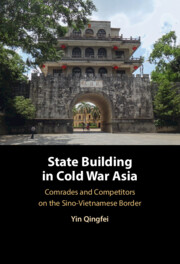Book contents
- Frontmatter
- Contents
- Figures
- Maps
- Acknowledgments
- Notes on Romanization, Names, and Pseudonymization
- Abbreviations
- Introduction
- 1 Asymmetric State Building (1949–1954)
- 2 Joint State Building (1954–1957)
- 3 Negotiated State Building (1958–1964)
- 4 Thwarted State Building on the Sea (1954–1964)
- 5 Reversed State Building (1965–1975)
- Conclusion
- Bibliography
- Index
5 - Reversed State Building (1965–1975)
Published online by Cambridge University Press: 18 December 2024
- Frontmatter
- Contents
- Figures
- Maps
- Acknowledgments
- Notes on Romanization, Names, and Pseudonymization
- Abbreviations
- Introduction
- 1 Asymmetric State Building (1949–1954)
- 2 Joint State Building (1954–1957)
- 3 Negotiated State Building (1958–1964)
- 4 Thwarted State Building on the Sea (1954–1964)
- 5 Reversed State Building (1965–1975)
- Conclusion
- Bibliography
- Index
Summary
The new dynamics on the border epitomize how the escalation of the Vietnam War and the Cultural Revolution compounded the already wobbly state building campaign at the border. During the decade from 1965 to 1975, the war and the chaotic sociopolitical movement militarized the Sino-Vietnamese border and made this far-off region more relevant to the decision-making in Beijing and Hanoi about their internal power struggles and national security policies. Yet, these developments also shifted state-society relations on the political periphery in favor of a more porous boundary. Thus, the extension and contraction of state power took place simultaneously. Both Chinese and Vietnamese authorities launched ambitious infrastructure projects in the border area to facilitate the transportation of aid to Vietnam and mobilized the local society against the possible expansion of the war. The Sino-Vietnamese land and maritime border region, as well as the transportation lines running through it, became spaces of frequent interactions between the Chinese and Vietnamese officials regarding the provision of aid and the coordination of border defenses. The efficiency of these interactions, however, was increasingly susceptible to the decline of the Sino-Vietnamese partnership following the Tết Offensive and the start of negotiations between Hanoi and Washington in 1968.
Keywords
- Type
- Chapter
- Information
- State Building in Cold War AsiaComrades and Competitors on the Sino-Vietnamese Border, pp. 201 - 247Publisher: Cambridge University PressPrint publication year: 2024

